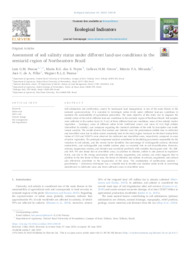Assessment of soil salinity status under different land-use conditions in the semiarid region of Northeastern Brazil.
Assessment of soil salinity status under different land-use conditions in the semiarid region of Northeastern Brazil.
Autoria: PESSOA, L. G. M.; FREIRE, M. B. G. dos S.; GREEN, C. H. M.; MIRANDA, M. F. A.; ARAUJO FILHO, J. C. de; PESSOA, W. R. L. S.
Resumo: Soil salinization and sodification, caused by inadequate land management, is one of the main threats to the semiarid agroecosystems. It is essential to investigate saline levels under different land-use conditions to maintain the sustainability of agricultural production. The main objective of this study was to diagnose the salinity status of the soil in different land-use conditions in the semiarid region of Northeast Brazil. Soil samples were collected in the surface layer (0-5 cm) of three different land-use conditions: areas of low salinity (native vegetation - Caatinga), areas of different saline levels (cultivated areas), and areas of very high salinity (desertified by salinity), and compared regarding the chemical attributes of the soils by descriptive and multivariate analysis. The results showed that sodium and chloride were the predominant soluble ions in cultivated and desertified areas due to saline waters commonly used in the study region. Increases in electrical conductivity values of 1219 and 23207% were observed for cultivated and desertified areas, respectively, compared to areas of native vegetation. The principal component analysis contributed to identifying parameters responsible for the variation in soil salinity, and the second factor identified that percentage of exchangeable sodium, electrical conductivity, and exchangeable and soluble sodium plays an essential role in soil desertification. However, calcium, magnesium, sodium, and chloride ions correlated positively with variables that degrade soils - EC, ESP, and SAR. We also found that in desertified areas, in addition to chloride, sulfate is also present in expressive levels, and due to the strong associations with calcium, magnesium, and sodium, our study suggests that in addition to the free forms of these ions, the forms of chlorides and sulfates of calcium, magnesium, and sodium also effectively contribute to the degradation of the areas. The combination of multivariate analysis × geochemistry × laboratory techniques was a valuable tool to identify and monitor saline levels in converting uncultivated to cultivated areas and from cultivated areas to desertified areas.
Ano de publicação: 2022
Tipo de publicação: Artigo de periódico
Unidade: Embrapa Solos
Palavras-chave: Climate change, Deterioração do Solo, Gestão, Mudança Climática, Saline soils, Sodic soils, Soil degradation, Soil management, Solo, Solo Salino, Solo Sódico
Observações
1 - Por padrão são exibidas publicações dos últimos 20 anos. Para encontrar publicações mais antigas, configure o filtro ano de publicação, colocando o ano a partir do qual você deseja encontrar publicações. O filtro está na coluna da esquerda na busca acima.
2 - Para ler algumas publicações da Embrapa (apenas as que estão em formato ePub), é necessário ter, no celular ou computador, um desses softwares gratuitos. Sistemas Android: Google Play Livros; IOS: iBooks; Windows e Linux: software Calibre.
Acesse outras publicações
Acesse a Base de Dados da Pesquisa Agropecuária (BDPA) para consultar o acervo completo das bibliotecas da Embrapa.

